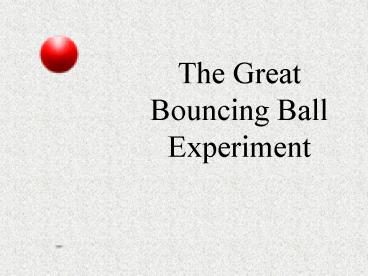The Great Bouncing Ball Experiment - PowerPoint PPT Presentation
1 / 17
Title:
The Great Bouncing Ball Experiment
Description:
The Great Bouncing Ball Experiment So Far, all of our work on graphs has been directed towards linear relationships. y = mx + b Linear relationships represent only a ... – PowerPoint PPT presentation
Number of Views:325
Avg rating:3.0/5.0
Title: The Great Bouncing Ball Experiment
1
The Great Bouncing Ball Experiment
2
So Far, all of our work on graphs has been
directed towards linear relationships.y mx b
3
Linear relationships represent only a small (but
important) part of the overall topic of
modeling.There are numerous other models you
will study in your high school career
4
The Quadratic
E mc2
5
The Cubic
6
The Quintic
7
Periodic Functions
8
Cardioid
Four Leaf
Lemicon
9
Mobius Transformation
10
(No Transcript)
11
A bouncing ball provides and excellent
illustration of a non-linear relationship.
Our work with non-Linear Relationships will be
limited to observation and recognition
12
Copy and complete the chart below
Trial 1 Trial 2 Trial 3 Average of 3 trials
Height (cm) (no decimals)
Initial Height NA NA NA
Height after 1 bounce
Height after 2 bounces
Height after 3 bounces
Height after 4 bounces
Height after 5 bounces
Height after 6 bounces
205
178
173
171
174
155
151
154
160
13
Copy and complete the chart below
Trial 1 Trial 2 Trial 3 Average of 3 trials
Height (cm) (no decimals)
Initial Height NA NA NA
Height after 1 bounce
Height after 2 bounces
Height after 3 bounces
Height after 4 bounces
Height after 5 bounces
Height after 6 bounces
14
- Draw a graph of Height VS Number of Bounces
H
0 1 2 3 4 5 6
B
15
Copy and complete the chart below
Trial 1 Trial 2 Trial 3 Average of 3 trials
Height (cm)
Start Height (0) NA NA NA
Height after 1 bounce
Height after 2 bounces
Height after 3 bounces
Height after 4 bounces
Height after 5 bounces
Height after 6 bounces
205
178
173
171
174
155
151
154
160
16
Questions
- 1. How would the graph change if you used a
bowling ball? - 2. How would the graph change if you threw the
ball down as hard as you could instead of dropped
it. - 3. How would the graph change if you did the
experiment on the moon?
17
- Hand in the completed graph and answered
questions once you finish.

